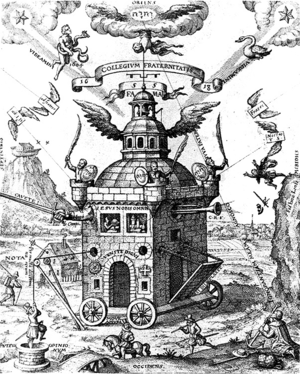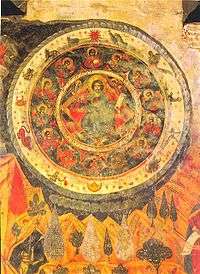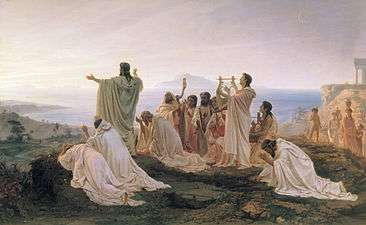Esoteric Christianity
Esoteric Christianity is an ensemble of Christian theology which proposes that some spiritual doctrines of Christianity can only be understood by those who have undergone certain rites (such as baptism) within the religion. The term esoteric was coined in the 17th century and derives from the Greek ἐσωτερικός (esôterikos, "inner").[1]
| Part of a series on |
| Spirituality |
|---|
|
Spiritual experience
|
|
Spiritual development |
| Influences |
|
Western General
Antiquity Medieval Early modern Modern |
|
Asian Pre-historic
Iran India East-Asia |
| Research |
|


These spiritual currents share some common denominators, such as heterodox or heretical Christian theology; the canonical gospels, various apocalyptic literature, and some New Testament apocrypha as sacred texts; and disciplina arcani, a supposed oral tradition from the Twelve Apostles containing esoteric teachings of Jesus the Christ.[2]
Ancient roots

Some modern scholars believe that in the early stages of proto-orthodox Christianity, a nucleus of oral teachings were inherited from Palestinian and Hellenistic Judaism. In the 4th century, it was believed to form the basis of a secret oral tradition which came to be called disciplina arcani. Mainstream theologians, however, believe that it contained only liturgical details and certain other traditions which remain a part of some branches of mainstream Christianity.[2][3][4] Important influences on Esoteric Christianity are the Christian theologians Clement of Alexandria and Origen, the leading figures of the Catechetical School of Alexandria.[5]
Reincarnation was accepted by most Gnostic Christian sects such as Valentinianism and the Basilidians, but denied by the proto-orthodox one. While hypothetically considering a complex multiple-world transmigration scheme in De Principiis, Origen denies reincarnation in unmistakable terms in his work Against Celsus and elsewhere.[6][7]
Despite this apparent contradiction, most modern Esoteric Christian movements refer to Origen's writings (along with other Church Fathers and biblical passages[8]) to validate these ideas as part of the Esoteric Christian tradition outside of the Gnostic schools, who were later considered heretical in the 3rd century.[9]
Scholar Jan Shipps describes The Church of Jesus Christ of Latter-day Saints as having esoteric elements.[10]
See also
- Anthroposophy
- Astrological age
- Book of the 24 Philosophers
- Charismatic Christianity
- Christianity and Neopaganism
- Christianity and Paganism
- Christianity and Theosophy
- Christian Kabbalah
- Christian meditation
- Christian mysticism
- Christian mythology
- Christian theosophy
- Christian views on astrology
- Christian views on magic
- Esoteric astrology
- Gnosticism
- Hermetica
- Manichaeism
- Martinism
- Neoplatonism
- Occult
- Origins of Christianity
- Rosicrucianism
- Spirituality
- "The Esoteric Character of the Gospels"
References
- Oxford English Dictionary Compact Edition, Volume 1, Oxford University Press, 1971, p. 894.)
- G.G. Stroumsa, Hidden Wisdom: Esoteric Traditions and the Roots of Christian Mysticism, 2005.
- Frommann, De Disciplina Arcani in vetere Ecclesia christiana obticuisse fertur, Jena 1833.
- Edwin Hatch, The Influence of Greek Ideas and Usages upon the Christian Church, London: Williams and Norgate, 1907, Lecture X.
- Jean Daniélou, Origen, translated by Walter Mitchell, 1955.
- Catholic Answers, Quotes by Church Fathers Against Reincarnation Archived June 28, 2011, at the Wayback Machine, 2004.
- John S. Uebersax, Early Christianity and Reincarnation: Modern Misrepresentation of Quotes by Origen, 2006.
- See Reincarnation and Christianity
- Archeosofica, Articles on Esoteric Christianity Archived 2007-11-02 at the Wayback Machine (classical authors)
- Shipps, Jan. The Mormons: Looking Forward and Outward. Christian Century, August 16-23, 1978, pp. 761-766.
Further reading
- Anonymous [Valentin Tomberg] (1985). Meditations on the Tarot: A Journey Into Christian Hermeticism. New York, NY: Tarcher/Penguin. ISBN 978-1-5854-2161-9
- Besant, Annie (2001). Esoteric Christianity or the Lesser Mysteries. City: Adamant Media Corporation. ISBN 978-1-4021-0029-1.
- Brown, Coleston (2007). Magical Christianity: The Power of Symbols for Spiritual Renewal.Wheaton, IL: Quest Books. ISBN 978-0-8356-0855-8
- Duncan, Anthony (1972, 1996). The Lord of the Dance: An Essay in Mysticism. Sun Chalice Books. ISBN 978-0-9650-8395-9
- Knight, Gareth (1975, 2010). Experience of the Inner Worlds. Cheltenham, Gloucestershire: Skylight Press. ISBN 978-1-9080-1103-9
- Knight, Gareth (2011). A History of White Magic. Cheltenham, Gloucestershire: Skylight Press. ISBN 978-1-9080-1104-6
- Powell, Robert. (2007). The Sophia Teachings: The Emergence of the Divine Feminine in Our Time. Aurora, CO: Lindisfarne Books. ISBN 978-1-5842-0048-2
- Rittelmeyer, Friedrich (Author), Mitchell, M.L. (Translator) (2004). Meditation: Letters on the Guidance of the Inner Life 1932. Whitefish, MT: Kessinger Publishing, LLC. ISBN 978-1-4179-7983-7
- Smoley, Richard (2002). Inner Christianity: A Guide to the Esoteric Tradition.Boston, MA: Shambhala Publications. ISBN 978-1-5706-2810-8
- Steiner, Rudolf (1997). Christianity As Mystical Fact And The Mysteries Of Antiquity. Great Barrington, MA: Anthroposophic Press. ISBN 978-0-8801-0436-4
External links
| Wikimedia Commons has media related to Esoteric Christianity. |